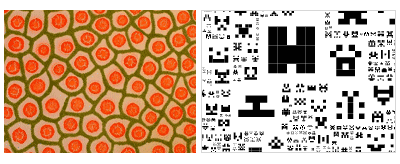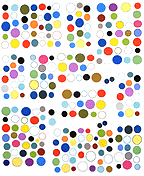View current page
...more recent posts

In David Szafranski's paintings, a group of which were linked to here, dataisnature sees some biological and mathematical underpinnings:
Itís the human equivalent of a Diffusion Aggregation Limitation system - whereby particles in solution diffuse randomly until they move near to a piece of solid structure, at which point they come out of solution and form part of the aggregate, resulting in dendritic structures. All of the works have a similar quality and evoke the idea of the human-computer in repetitive sub-routines crystallizing the work into existence.To illustrate the human-computer connection, DIN pairs a detail of a Szafranski painting with a section of a computer-generated drawing by Jared Tarbell (reproduced above). Continuing the conversation and emphasizing the links between "cyber" and "natural" diffusion models, Szafranski, no slouch in the computational department as well being a kick ass painter, has posted a seductive animated GIF [1 MB .GIF] that applies some of the principles of growth and space-filling DIN mentions.
The actual physical makeup of the paintings, though, in contrast to the ethereal GIF and DIN's elegant theory, suggests a more problematic relationship to science. Made of glue, spray paint, and modeling store synthetic grass, in semi-stable combinations certain to give art world painting fetishists fits, the canvases may evoke principles of fractal orderliness on a compositional level, but materially they revel in decay and punk anarchy: the mien of safety pins through the cheek rather than white lab coats.
